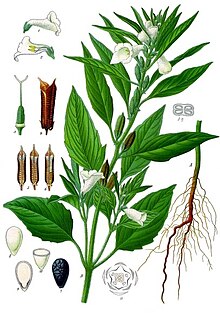
Back Sesam AF ሰሊጥ AM سمسم Arabic ܫܘܫܡܬܐ ARC سمسم ARZ তিল AS Sesamum indicum AST Hind küncütü AZ هیند کونج اوْتو AZB Lenga BAN
| Sesame | |
|---|---|

| |

| |
| Sesame plants | |
| Scientific classification | |
| Kingdom: | Plantae |
| Clade: | Tracheophytes |
| Clade: | Angiosperms |
| Clade: | Eudicots |
| Clade: | Asterids |
| Order: | Lamiales |
| Family: | Pedaliaceae |
| Genus: | Sesamum |
| Species: | S. indicum
|
| Binomial name | |
| Sesamum indicum | |
| Synonyms[1] | |
| |
Sesame (/ˈsɛsəmi/;[2][3] Sesamum indicum) is a plant in the genus Sesamum, also called benne or gingelly.[4] Numerous wild relatives occur in Africa and a smaller number in India.[5] It is widely naturalized in tropical regions around the world and is cultivated for its edible seeds, which grow in pods. World production in 2018 was 6 million tonnes (5,900,000 long tons; 6,600,000 short tons), with Sudan, Myanmar, and India as the largest producers.[6]
Sesame seed is one of the oldest oilseed crops known, domesticated well over 3,000 years ago. Sesamum has many other species, most being wild and native to sub-Saharan Africa.[5] S. indicum, the cultivated type, originated in India.[7][5] It tolerates drought conditions well, growing where other crops fail.[8][9] Sesame has one of the highest oil contents of any seed. With a rich, nutty flavor, it is a common ingredient in cuisines around the world.[10][11] Like other foods, it can trigger allergic reactions in some people and is one of the nine most common allergens outlined by the Food and Drug Administration (FDA).[12][13]
- ^ "The Plant List: A Working List of All Plant Species". Retrieved 14 January 2015.
- ^ Jones, Daniel (2011). Roach, Peter; Setter, Jane; Esling, John (eds.). Cambridge English Pronouncing Dictionary (18th ed.). Cambridge University Press. ISBN 978-0-521-15255-6.
- ^ Wells, John C. (2008). Longman Pronunciation Dictionary (3rd ed.). Longman. ISBN 978-1-4058-8118-0.
- ^ "Definition of BENNE". Merriam Webster Dictionary. Retrieved 2023-02-08.
- ^ a b c Bedigian, Dorothea (2015-01-02). "Systematics and evolution in Sesamum L. (Pedaliaceae), part 1: Evidence regarding the origin of sesame and its closest relatives". Webbia. 70 (1). University of Florence: 1–42. Bibcode:2015Webbi..70....1B. doi:10.1080/00837792.2014.968457. ISSN 0083-7792. S2CID 85002894.
- ^ Cite error: The named reference
faostatwas invoked but never defined (see the help page). - ^ Cite error: The named reference
Y. P. S. Bajajwas invoked but never defined (see the help page). - ^ Cite error: The named reference
rramwas invoked but never defined (see the help page). - ^ Cite error: The named reference
drl2was invoked but never defined (see the help page). - ^ Cite error: The named reference
rhanwas invoked but never defined (see the help page). - ^ Cite error: The named reference
esoplwas invoked but never defined (see the help page). - ^ Cite error: The named reference
adatiawas invoked but never defined (see the help page). - ^ Cite error: The named reference
SesameLaw2021was invoked but never defined (see the help page).